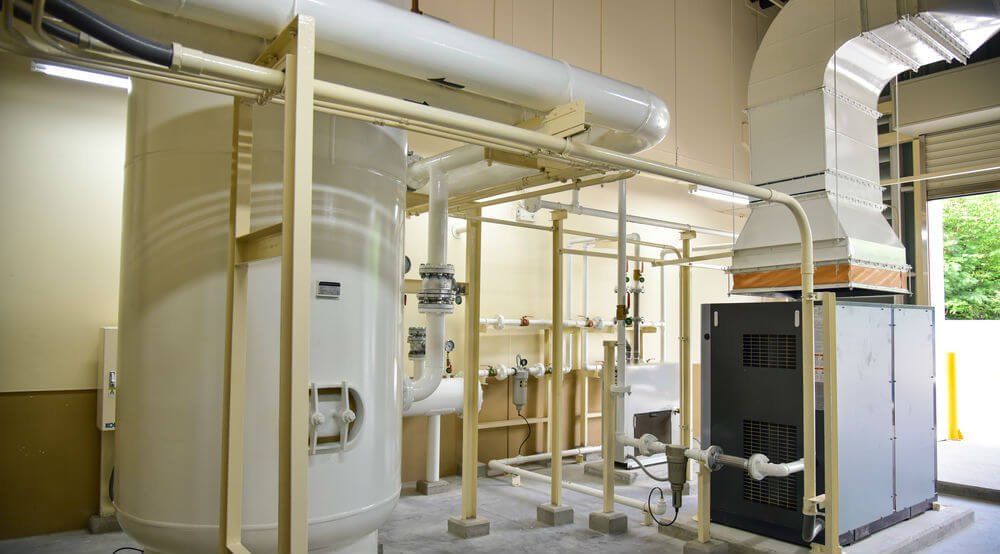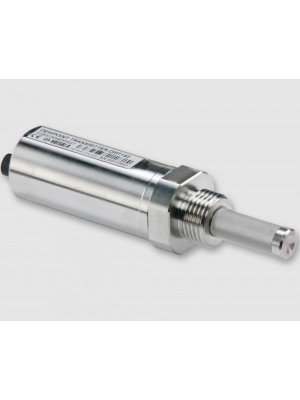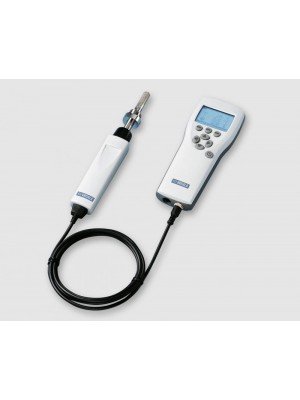
Compressed Air Dryer Key Performance Indicators
Pressure Dew PointThe most important KPI to monitor is the pressure dew point (PDP) of the compressed air exiting the dryer(s). The PDP of the compressed air should be monitored at the discharge of each dryer and downstream of where the compressed air from multiple dryers converges. The combined PDP measurement of multiple dryers is important for a couple of reasons. First, it only takes a small of wet air to ruin the PDP of the air exiting the other dryers and secondly, the dew point spikes from multiple heated desiccant dryers may occur one after the other; thereby producing a poor PDP even though the dryers are operating correctly. The effect of the dew point spikes can be minimized by operating all the dryers in fixed mode and synchronizing them so they switch towers at the same time. The PDP alarm for heated desiccant dryers should have a sufficient delay to allow time for the dew point spike to go away.
KPI’s for All Dryer TypesThe following items can affect the performance of all types of compressed air dryers. - Liquid Oil and Water (Condensate) - Inlet Flow - Inlet Air Temperature - Inlet Pressure - Ambient Temperature - Inlet Water Temperature and Flow - Dirty/Fouled Coolers - Failed Auto Drains and Plugged Drain Lines
Liquid Oil and Water (Condensate)Typically, after the compressed air is cooled in the compressor’s aftercooler it is 100 percent saturated and as it flows through the piping between the compressor and the dryer it cools and moisture and oil condense in the piping. The amount of moisture and oil that condenses depends upon the temperature differential between the compressed air in the piping and the ambient temperature and the distance between the compressor and the dryer. Many refrigerated dryers are installed without pre- or after-filters so the condensed moisture and oil can slug the dryer and its internal separator preventing the dryer from drying the air and the separator from removing it from the system. Regenerative desiccant dryers normally have a pre-filter installed upstream of the dryer, but that does not prevent moisture and oil from passing through the filter element nor does it prevent moisture and oil from condensing downstream of the pre-filter. For example, a coalescing filter’s flow rating is typically based upon a maximum of 50 PPM w/w that includes water, oil, aerosols, and solids. Any air contaminates above 50 PPM w/w reduces the filters rated capacity and when they exceed 200 PPM w/w moisture and oil could be bypassing the filter element. If liquid moisture reaches the desiccant it reduces the dryer’s ability to maintain the required PDP; however, if liquid oil reaches the desiccant it ruins the desiccant. Installing a Mist Eliminator or NL Module or a properly sized wet air receiver as close to the dryer pre-filter as possible can prevent overloading of the pre-filter. In addition, if the ambient temperature is low enough the piping between the wet air receiver and the pre-filter and the pre-filter and the dryer inlet should be insulated. The issue with condensate has been observed in both indoor and outdoor installation. Issues with condensate typically occur indoors when the compressor is air-cooled and there is a substantial differential between the compressor discharge temperature and the ambient temperature. For example, in an indoor location where a large amount of condensate occurred in the piping upstream of the dryer, the air-cooled compressor discharge temperature was 110⁰F and the ambient temperature was 87⁰F. The distance between the compressor and the dryer was approximately 50 feet.
Inlet Conditions (Flow, Temperature, Pressure, Ambient/Cooling Water Temperature)A dryer’s capacity is directly related to its inlet pressure and indirectly to its inlet air and ambient/cooling water temperatures; therefore, its capacity varies constantly as these items change. Monitoring the dryer’s inlet pressure, inlet temperature, and if applicable the ambient/cooling water temperature allows one to calculate its present capacity and then compare it to the dryer’s monitored inlet flow. By using the monitored values the dryer’s capacity could be formulated in a computer so the comparison could be shown in real time. Note: A dryer’s inlet pressure and temperature should be monitored downstream of any prefilters and as close the dryer/towers as possible. While an inlet flow in excess of the dryer’s capacity prevents it from maintaining an acceptable pressure dew point (PDP), too low of a flow can reduce the efficiency of some moisture separators contained in some refrigerated dryers and regenerative desiccant dryers containing a cooler. The reduced efficiency of the moisture separator can result in moisture and/or oil being carried over into the compressed air system or into the regenerative desiccant dryer’s desiccant. In addition, split-stream and some heat-of-compression regenerative desiccant dryers require a minimum flow to ensure regeneration of the desiccant.
Cooling Water Temperature, Flow, & Cooler Outlet Air TemperatureMonitoring the cooling water temperature is particularly important on split-stream and heat-of-compression regenerative desiccant dryers because the hot air used to regenerate the desiccant should be cooled to 100⁰F for the dryer to maintain a -40⁰F PDP. Because most shell and tube heat exchangers used have a 15⁰F approach temperature they require a cooling water temperature of 85⁰F or less so in those installations where the cooling water temperature exceeds 85⁰F split-stream and heat-of-compression regenerative desiccant dryers probably won’t maintain a -40⁰F PDP.
Dirty/Fouled CoolersA dirty condenser in refrigerated dryers is a common problem that results in a poor PDP. In the case of shell and tube heat exchangers, monitoring the cooler’s outlet air temperature notifies you of a problem and monitoring the cooling water temperature and flow lets you know if the cooler needs to be cleaned or if there is a problem with the water supply.
Failed Auto Drains & Plugged Drain LinesAuto drains are normally installed at the moisture separator downstream of the air compressor’s aftercooler, the wet air receiver, the dryer prefilter, and the moisture separator installed inside refrigerated dryers and some types of regenerative desiccant dryers. Auto drains can fail open or closed. When auto drains fail open they waste compressed air, but when they fail closed or the drain line becomes plugged moisture and/or oil will flow out into the compressed air system or into the desiccant. Plugged drain lines typically occur in “oil-free” compressed air systems so the drain lines should be stainless steel. Some electrically-operated “No-Air Loss” auto drains offer local or remote alarms, while some pneumatically-operated ones offer local or remote counters.
Additional KPI’s for Regenerative Desiccant DryersThe following items are specific to the performance of regenerative desiccant dryers. - Purge Flow - Backpressure in the Offline Tower of Desiccant Dryers - Valve Failures - Regeneration Temperature on Heated Desiccant Dryers - Dirty Filters or Backpressure on the Blowers of Heated Blower Purge Dryers
Purge FlowThe formula, shown below, is for the purge flow required by a “Heatless” dryer. The formula shows that the required purge flow varies directly with inlet flow and indirectly with inlet pressure. This means if the inlet flow is the same as the dryer’s rated flow and the inlet pressure falls below 100-psig then the purge flow must be increased. Qp = (Q x 1.15) / ((P + 14.7) / 14.7) Qp = Purge Flow (scfm) Q = Inlet Flow (scfm) P = Inlet Pressure (psig) Correctly setting the purge flow is normally addressed by initially setting it for the lowest expected pressure and the peak flow so monitoring the purge flow is not necessary; however, because we cannot trust the dryer’s purge pressure gauge, monitoring the purge pressure is recommended. In order to reduce energy and recover compressor capacity some recommend reducing the purge flow if the peak flow is below the dryer’s corrected flow rating; however, doing has resulted in poor system reliability so it not recommended.
Backpressure in the Offline Tower of Desiccant DryersBackpressure in the offline tower prevents the purge air from fully expanding; thereby, reducing the purge air flow, which in turn reduces the dryer’s ability to regenerate the desiccant. The dryer’s two towers are equipped with pressure gauges; however, they can’t always be trusted so installing pressure transducers and monitoring the pressure is recommended.
Desiccant Dryer Valve FailuresWhen a desiccant dryer’s valves fail compressed air from the online tower can flow into the offline tower and then out the purge exhaust valve. Depending upon the purge exhaust valve’s Cv a valve failure can dump the full capacity of the upstream compressor(s) resulting in a plant outage. Also, when a dryer’s valve fails, but sufficient compressor capacity exists to maintain the system pressure, the reason for the increased demand and poor dryer performance is often hidden from the end user. Therefore, monitoring the regenerative dryer’s inlet and outlet flows, along with installing a trip valve in the purge exhaust line that trips and alarms on low system pressure is recommend. Some manufacturers’ dryer controls close the dryer’s purge exhaust valve(s) on low pressure; however, because these valves fail as often as the other dryer valves, installing a trip valve is preferred. The problem with installing a check valve downstream of the dryer is twofold. Firstly, the purge exhaust valve may be able to exhaust the capacity of more than one compressor, which means that a backup compressor located upstream of the dryer may not be able to maintain the system pressure. Secondly, when the check valve closes the compressor capacity installed upstream of the dryer is effectively removed from the system; whereas, installing a trip valve maintains its capacity.
Regeneration TemperatureThe regeneration temperature of heated desiccant dryers should be monitored because they require a minimum regeneration temperature to maintain a -40⁰F PDP. Also, monitoring the heater kW is recommended, particularly on internally heated dryers.
Dirty Filters or backpressure on the Blowers of Heated Blower Purge DryersAs the pressure drop increases across the blower’s inlet filter the purge flow reduces so the pressure drop should be monitored. Also a failed check valve can create backpressure on the blower; thereby, reducing its flow, so the blowers discharge pressure should be monitored.
Other Items that can affect the Performance of Regenerative Desiccant DryersUsing Energy Saving Controls on Desiccant Dryers – Operating a regenerative desiccant dryer in its Energy Savings mode saves energy and can increase the life of the desiccant; however, it does reduce the system’s PDP. Failed Dew Point Monitors on Desiccant Dryers – Dew point monitors fail low so when they fail they can prevent a dryer that is operating in its Energy Savings mode from switching towers; therefore, it’s important to maintain the dew point monitor on a regular basis. Failing to shut off a Dedicated Desiccant Dryer when its Compressor is Shut Off – This issue only occurs in system where the dryers are dedicated to the compressors, the system contains oil-flooded air compressors, and there is oil in the main header downstream of the dryers. In this situation if the regenerative dryer isn’t shut off the purge air will pull oil out of the main header as it flows backward through the dryer’s afterfilter into the desiccant and out the purge exhaust muffler. The oil will ruin the desiccant along with the dryer’s dew point monitor. Installing a check valve downstream of the dryer can resolve this issue. Worn-out Desiccant – The life of the desiccant in regenerative desiccant dryers depends upon how the dryer is integrated into the system, the quality of the desiccant, and how the dryer is operated and maintained. The following are manufacturer’s estimated desiccant life for the different types of regenerative desiccant dryers. “Heatless” dryers – 3 to 5 years Heated dryers – 2 to 3 years Heat-of-Compression dryers – 1-2 years Source: https://www.airbestpractices.com/technology/air-treatmentn2/compressed-air-dryer-key-performance-indicators
We distribute a range of stable and reliable dew point transmitters both for OEM configurations as well as for end users: dewpoint for compressed air, dewpoint for air dryer, dewpoint for hopper |




.png)

































All comments